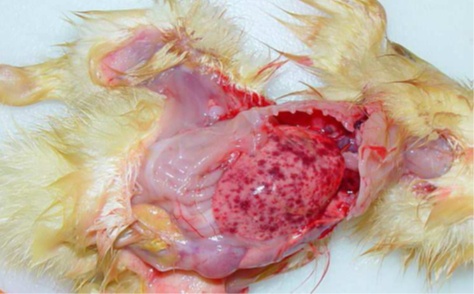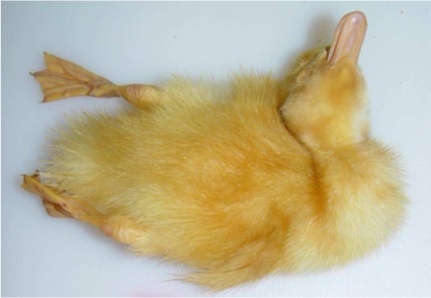First described in 1948 in the United States, this disease was first described in Europe in 1956.
Extremely contagious, it is characterized by a high mortality rate, with or without nervous disorders, in young Pekin or Mulard ducklings. Currently, the widespread vaccination of future breeders has considerably reduced its incidence.
However, the virus responsible for this disease seems to be at the origin of another pathological entity in Muscovy ducks, combining pancreatitis and encephalomyelitis
The disease agent and its pathogenicity
“The viral hepatitis of the duckling” is caused by several viral entities called Duck Hepatitis virus (DHV) -1, -2 or -3 which are discriminated on the basis of serological specificities and minimal anatomo-clinical nuances.
DHV-1 is a virus of the Picornaviridae family : it is an unenveloped RNA virus with a diameter of 20 to 30 nanometres, with of 32 capsomers.
It is a very resistant virus that can persist in the environment for 10 weeks at room temperature.
The entry route is digestive, but can spread to many organs : liver, pancreas, even central nervous system.
Epidemiological data
The source of the virus is represented by sick ducks and healthy carriers such as adults. Faeces and the contaminated external environment are also a good reservoir, given the high resistance of this type of virus.
Historically, only Pekin or Mulard ducklings were considered sensitive, but a new pathological entity associated with a DHV has recently been described in Muscovy ducks.
The virus therefore only affects young animals (1 to 3 weeks), but adults remain carriers. Transmission occurs from animal to animal, horizontally. The virus’ entry route is digestive. Incubation is very fast and lasts 2 to 4 days.
Clinical manifestations of the disease
Symptoms
The clinic is often spectacular, without any real prodromes. Significant mortality occurs rapidly, with or without nervous signs (tremulation, head oscillations, opisthotonos)
Lesions
- In Pekin or Mulard duckling : at the macroscopic level, the necropsy picture is dominated by hepatic damage : hepatomegaly, petechiae and hemorrhagic suffusions on the surface and in the liver parenchyma.
Histology generally reveals degenerative and necrotizing hepatitis of varying intensity and extent. Associated with nervous signs, it is shown to have an unpurified encephalitis on other organs, mainly renal, are inconsistent and not very intense. - In Muscovy duckling : the necropsy mainly shows pancreatic hypertrophy, sometimes visible through the abdominal wall. Splenomegaly and sometimes discreet hepatic congestion are also noted.
At the histological level, pancreatic lesions consist of a disintegrating necrosis mainly affecting the exocrine parenchyma. Nerve damage, which is multifocal, occurs mainly in the cerebral hemispheres and the cerebellum. They correspond respectively to severe gliosis with satellitosis, and neuronal necrosis with spheroids, demyelination and gliosis). Perivascular cuffs with lymphoplasmocytic cell are regularly associated with the lesions. The spleen is usually hyperplastic and there are sometimes some discrete necrotic foci in the liver.
The diagnosis
Epidemio-clinical diagnosis
It is the main diagnosis. The sudden appearance of significant mortality in young ducklings, associated with nervous signs and liver damage at necropsy, almost provides a diagnosis of certainty. If other conditions are also responsible for high sudden mortality in the duckling (viral enteritis, bacterial septicaemia, sudden death syndrome, coccidiosis and mycotoxicosis), the necropsy usually leads to a conclusion.
Laboratory diagnosis
The advent of molecular biology techniques has considerably facilitated it. Currently, a conventional RT-PCR test, targeted on a specific gene of the duckling hepatitis virus genome, is available.


Disease prevention and control
Treatment
There is no specific treatment. Mortality decreases beyond 4 weeks of age. Improving animal comfort, using antibiotics to limit secondary infections, can help survivors get through the infection.
The virus is highly resistant in the external environment and the risks of contamination between adjacent sheds or between successive batches require stringent biosecurity measures. In particular, care should be taken to strengthen cleaning and disinfection protocols.
Vaccination
A live attenuated injectable vaccine is currently available in France (Hepatovax ND, Merial). It provides effective protection for the young animal when administered within the first few weeks of life. (From 1 day in ducklings from unvaccinated parents). Vaccination of female breeding ducks before laying allows the transfer of protective maternal immunity to the duckling. This practice, which is now totally widespread, has led to a very sharp decrease in the number of cases in the field.







